
Erythronium, the fawn lily, trout lily, dog's-tooth violet or adder's tongue, is a genus of Eurasian and North American plants in the lily family, most closely related to tulips. The name Erythronium derives from Ancient Greek ἐρυθρός (eruthrós) "red" in Greek, referring to the red flowers of E. dens-canis. Of all the established species, most live in North America; only six species are found in Europe and Asia.

In biology, stolons, also known as runners, are horizontal connections between parts of an organism. They may be part of the organism, or of its skeleton. Typically, animal stolons are exoskeletons.
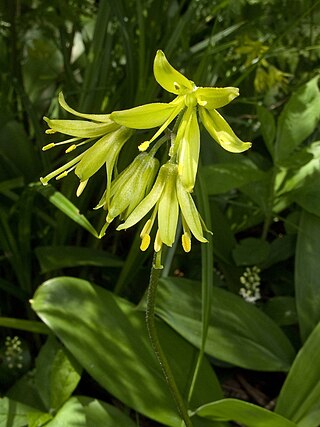
Clintonia borealis is a species of flowering plant in the lily family Liliaceae. The specific epithet borealis means "of the north," which alludes to the fact that the species tends to thrive in the boreal forests of eastern Canada and northeastern United States.

Erythronium albidum, the white fawnlily or white trout lily, is a small herbaceous geophyte in the lily family. It is also known as adder's tongue, whitedog's-tooth violet, serpent's tongue, trout lily, deer tongue, creeklily and yellow snowdrop. Large numbers of this plant indicate that the woodland has never been subjected to heavy machinery, where it would be unable to grow due to soil compaction.

Erythronium americanum, the trout lily, yellow trout lily, fawn lily, yellow adder's-tongue, or yellow dogtooth violet, is a species of perennial, colony forming, spring ephemeral flower native to North America and dwelling in woodland habitats. Within its range it is a very common and widespread species, especially in eastern North America. The common name "trout lily" refers to the appearance of its gray-green leaves mottled with brown or gray, which allegedly resemble the coloring of brook trout.
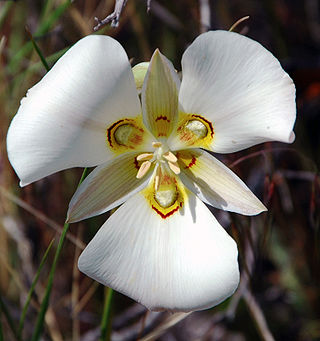
Calochortus nuttallii, also known as the sego lily, is a bulbous perennial plant that is endemic to the Western United States. The common name of sego comes from a similar Shoshone word. It is the state flower of Utah.

Erigenia bulbosa, also known as harbinger of spring or pepper and salt, is a flowering perennial plant in the family Apiaceae. E. bulbosa is the only species in the genus Erigenia and tribe Erigenieae. This plant is known as harbinger of spring because it is one of the earliest blooming native wildflowers of rich forests in the mid-latitude United States. Throughout most of its range it blooms from late February through early April.

Erythronium revolutum is a species of flowering plant in the family Liliaceae which is known by several common names, including mahogany fawn lily, coast fawn lily, and pink fawn lily. It is native to the west coast of North America.
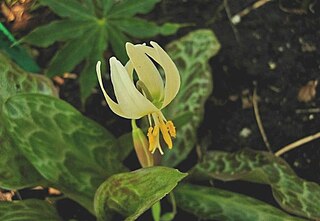
Erythronium citrinum, also known as citrus fawn lily or cream fawn lily, is a member of the lily family that is endemic to the Klamath Mountains. It is found in southwest Oregon and adjacent northwest California. The genus Erythronium, which can be found across northern North America, Europe and Asia, is most diverse in California, which is home to fifteen of about twenty-eight members of the genus.

Erythronium oregonum is a North American species of flowering plant in the lily family which is known by the common name giant white fawnlily or Oregon fawn-lily.
Erythronium pluriflorum is a rare species of flowering plant in the lily family Liliaceae which is known by the common names manyflower fawn lily,golden fawn-lily, and Shuteye Peak fawn lily.
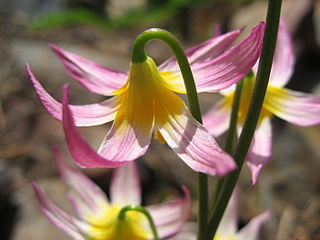
Erythronium purpurascens is a species of flowering plant in the lily family which is known by the common names purple fawn lily and Sierra Nevada fawn lily.

Erythronium pusaterii is a species of flowering plant in the lily family known by the common names Kaweah Lakes fawn lily and Hocket Lakes fawn lily.

Rubus pubescens is a herbaceous perennial widespread across much of Canada and the northern United States, from Alaska to Newfoundland, south as far as Oregon, Colorado, and West Virginia.

Erythronium taylorii is a rare species of flowering plant in the lily family known by the common names Pilot Ridge fawn lily, Taylor's fawnlily, and Yosemite fawn lily. It is endemic to Tuolumne County, California, where it is known only from Pilot Ridge, a remote mountain ridge outside of Yosemite National Park. It was discovered in 1996 and described to science as E. taylori in 1997, and it is now called E. taylorii. There are at least 1000 individuals in the single known population. It occurs on shaded north-facing cliffs.
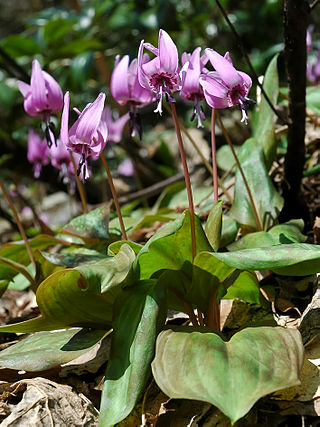
Erythronium japonicum, known as Asian fawn lily, Oriental fawn lily, Japanese fawn lily is a pink-flowered species trout lily, belonging to the Lily family and native to Japan, Korea, the Russian Far East and northeastern China. It is a spring ephemeral, blooming April–June in woodlands. It is known as zhūyáhuā (猪牙花) in Chinese, eolleji (얼레지) in Korean, and katakuri in Japanese.
Erythronium elegans is a rare species of flowering plant in the lily family known by the common names Coast Range fawnlily and elegant fawnlily. It is endemic to Oregon in the United States, where it is known from about 12 occurrences in the northern Coast Range.

Erythronium umbilicatum, the dimpled trout lily, is a species of flowering plant in the lily family. It is native to the Southeastern United States, primarily in the Piedmont and Southern Appalachian areas. It is reported from West Virginia, Alabama, Florida, Georgia, Kentucky, Maryland, North Carolina, South Carolina and Virginia.

Erythronium mesochoreum, the prairie fawn lily or midland fawnlily, is a plant species in the lily family, native to the US states of Illinois, Iowa, Indiana, Nebraska, Kansas, Missouri, Oklahoma, Texas and Arkansas.

Erythronium rostratum, the yellow trout lily, yellow fawnlily, beaked trout lily, or golden-star, is a plant species native to the south-central part of the United States.




















